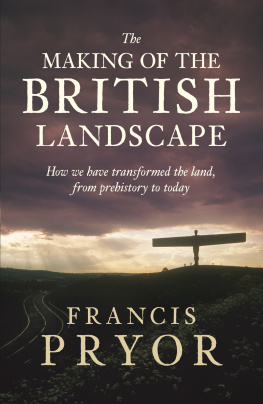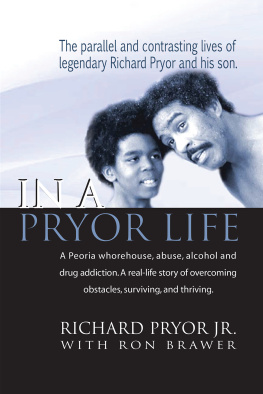Scenes From
Prehistoric Life
Scenes From
Prehistoric Life
FROM THE ICE AGE TO THE COMING OF THE ROMANS
FRANCIS PRYOR
AN APOLLO BOOK
www.headofzeus.com
An Apollo book
First published in the UK in 2021 by Head of Zeus Ltd
Copyright Francis Pryor, 2021
The moral right of Francis Pryor to be identified as the author of this work has been asserted in accordance with the Copyright, Designs and Patents Act of 1988.
All rights reserved. No part of this publication may be reproduced, stored in a retrieval system, or transmitted in any form or by any means, electronic, mechanical, photocopying, recording, or otherwise, without the prior permission of both the copyright owner and the above publisher of this book.
A catalogue record for this book is available from the British Library.
ISBN (HB): 9781789544145
ISBN (E): 9781789544169
Maps by Jeff Edwards
Head of Zeus Ltd
58 Hardwick Street
London EC 1 R 4 RG
WWW . HEADOFZEUS . COM
In fond memory of Teddy Faure Walker
(September 1946June 2018)
Contents
Introduction
Setting the Scenes
Scenes Landscapes Chronology
Scene 1
Britain During the Ages of Ice (900,000500,000 years ago)
Happisburgh Pakefield Boxgrove
Scene 2
The Persistence of Caves: Life, Death and the Ancestors (30,000 years ago600 BC )
Goats Hole Cave, Paviland Killuragh and Sramore Caves Robbers Den Cave
Scene 3
Inhabiting the Post-Glacial Landscape: Living on the Plains (9000 BC )
The Vale of Pickering Glacial Lake Flixton
Scene 4
From Wood to Stone on Salisbury Plain (80003000 BC )
The Stonehenge Car Park The Avenue Blick Mead Spring Stonehenge
Scene 5
Hunters Become Farmers (from 4000 BC )
Fengate Etton and Windmill Hill Clava Cairns Tomnaverie
Scene 6
From Stone to Bronze: Stone Quarries and Special Places (40002500 BC )
The Pike OStickle, Langdale Orkney Islands
Scene 7
Axes and Identities: Bronze Age Individuality and Family Ties (2500900 BC )
Holme-next-the-Sea Stonehenge
Scene 8
Getting About: On Land (40002000 BC )
The Amesbury Archer The Sweet Track
Scene 9
Getting About: On Coastal Waters (200070 BC )
The Dover Boat Folkestone and Flag Fen
Scene 10
Food and Round-houses (1500 BCAD 43)
Cornish Samphire Fengate Turf Roof Little Butser
Scene 11
Prosperity from Mud and Mire (1200 BCAD 300)
The Red Hills of Essex Northey and Fengate Tetney and the Lincolnshire Marshes Cowbit and the Fens
Scene 12
Living near Water (1000 BCAD 200)
Atlantic Britain Fenland Farmers Loch Tay and the Isle of Skye
Scene 13
Of Trees, Carpenters and Wheelwrights: The Growing Importance of Woodworking Skills in the Bronze and Iron Ages (1500 BCAD 43)
Buckets from Thorney The Fengate Wooden Stake Woodland Management The Flag Fen Wheel
Scene 14
Life in the Sky: Hillforts (1200100 BC )
Maiden Castle Danebury Dorset Hillforts Pen Dinas and Cardigan Bay
Scene 15
And What Then? Daily Life in Roman Times ( AD 43410) and Later
Rural Roman Britain West Stow Canterbury Brixworth
Setting the Scenes
Scenes Landscapes Chronology
Modern archaeology can sometimes seem miraculous. It is transforming our understanding of what it would have been like to have lived in Britain and Ireland in the million or so years that human beings have occupied this land. We are discovering about daily life in the warmer interludes of the Ice Age and in the centuries that followed, and we are revealing undreamt-of information about the settlements, economies and lifestyles of the millions of people who led highly organized, civilized lives in the four millennia before Christ.
The more we learn, the more we realize that prehistoric communities were extremely adaptable and were able to settle in a number of very different landscapes, some of which we might view, even today, as being quite challenging, if not actually hostile. This was done by keeping in regular touch with other, often quite widely separated, groups of people. Mutually agreed routes, which later developed into paths, trackways and roads, must have been a feature of the landscape from earliest times. Travel encouraged the spread of new ideas and it also ensured that human and animal bloodlines avoided isolation and, with it, inbreeding.
There has been a huge increase in archaeological activity since planning laws changed in the late 1980s. This has produced large regional data sets of sites, monuments and finds, both excavated and still in the ground. These are now so vast that there is a danger that any overview of British and Irish prehistory would soon become swamped by facts and figures. In my experience, too many statistics tend to obscure general themes. So in this book I want to sidestep the detail and bring the people of prehistory to the fore: their beliefs, the way they lived their lives, how they acquired the essentials of existence, and how they interacted with those around them. If possible, I also want to glimpse these things both locally and across society as a whole. To achieve this I will have to focus on individual sites and landscapes. My emphasis will be on what it would have been like actually to have visited these places when they were inhabited many millennia ago. That way, I hope we will be able to capture something of the accelerating pace of prehistoric change.
I plan to cover the full time span of British and Irish prehistory, as we currently appreciate it, starting about a million years ago. During the earliest periods, the areas that were later to become the British Isles were often too cold to inhabit. As a consequence, survival of these very old sites is thin and fragmentary. Despite that, they have produced some remarkable finds, including the extraordinary discoveries at Boxgrove and Star Carr. These later four millennia will form the main chronological focus of this book.
But now I want to get a little more personal: archaeology, after all, is a humanity, not a hard science and its practitioners are only too human. Our own lives inevitably colour our views of time: past, present and future. For about sixteen years I was a member of Channel 4s Time Team , a programme that was last broadcast in 2014, but which has acquired a flourishing afterlife on digital channels and on YouTube. Time Team was popular because it brought archaeology to life: it showed how people coped with both simple problems and enormous challenges. Above all else, it focused on the daily routines of living, whether in an Iron Age round-house or a Victorian millworkers basement kitchen. These filmed scenes, or snapshots, from the past painted a far more vivid picture than a broad overview. And that is what I am going to attempt to do in this book, but in words and a few photos.
Time Team worked because each episode was specific: we investigated a particular community, at a given time in a known landscape (and we went to great pains, through our on-screen specialist Stewart Ainsworth, to get that landscape right). I plan to follow those principles here. So each Scene will concentrate on a particular landscape or group of landscapes, and I will use information from individual excavations and surveys to recreate a story that captures some aspect of what it might have been like to have lived there at a given time in prehistory. This book cannot pretend to offer a comprehensive view of ancient Britain, but I hope it will convey an impression of change. From around 4000 BC , thousands of small communities slowly evolved towards the strong tribal kingdoms that were eventually to confront the invading Roman army. My intention is to open front doors, peek behind curtains, look into farmyards, fields, gardens and cemeteries where ordinary life was being lived. And there we will see how the pace of change was increasing as time advanced. By the final five hundred years before Christ, the broad sweep of the British landscape would have become recognizable to many people living today: roads, fields, farms and villages had replaced the forests, moors, heaths and open floodplains that dominated the view when the first farmers arrived in Britain, four millennia earlier.
















